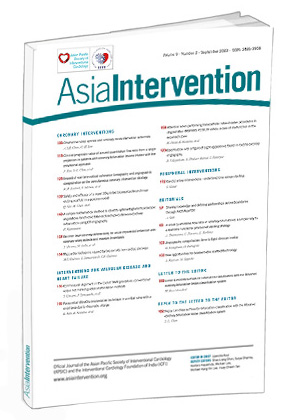Percutaneous coronary interventions (PCI) in bifurcation lesions are technically challenging because of the bifurcation angle, the extent and severity of side branch (SB) disease, and dynamic changes in plaque distribution that occur during the intervention. PCI in bifurcations is often associated with suboptimal clinical outcomes as compared to PCI in non-bifurcation lesions1. Provisional stenting of the SB is the recommended strategy for most bifurcation lesions, while an upfront two-stent strategy is reserved for bifurcation lesions with large SBs supplying significant myocardial territory2. However, determining the clinical relevance of an SB has always been extremely difficult. Recently, the Bifurcation Academic Research Consortium (Bif-ARC) has proposed a standardised algorithm consisting of a simple anatomical scoring system based on angiographic estimates of the myocardial mass at risk3.
As SBs supply the myocardium less than the main branches (MBs), the functional impact of SB stenosis in terms of significant ischaemia as assessed by fractional flow reserve (FFR) is lower than a similar stenosis in an MB4. The use of FFR to guide PCI of bifurcation lesions has consistently shown potential benefits in optimising treatment decisions and improving clinical outcomes5. However, there are technical considerations and limitations, such as the “branch steal effect”, the potential variations in FFR values due to wire position, the impact of the SB size and the interactions between stenoses in the MB and SB3. All these factors can lead to an underestimation in the SB functional assessment. Furthermore, SB rewiring is not always feasible after MB stenting, depending upon the geometrical and dynamic changes that occur at the level of the bifurcation PCI. In fact, in the DKCRUSH VI trial6, assessing the FFR of the SB was not viable in up to 10% of cases, primarily due to the challenging rewiring required with the pressure wire. In this context, the availability of angiographic functional assessment, such as quantitative flow ratio (QFR), Murray’s law-based quantitative flow ratio (mQFR), virtual FFR (vFFR), etc., could enhance the clinical adoption of functional assessment in the context of bifurcation lesions. Unlike QFR, mQFR has the additional advantage of requiring a single acquisition based on algorithms using fractal laws (i.e., Murray’s law in quantitative flow ratio).
The diagnostic accuracy of a novel QFR (μQFR) has been previously described7; yet, in this issue of AsiaIntervention, Kan et al8 significantly contribute to the available evidence by reporting on the prognostic impact of this functional analysis in bifurcations previously treated with main branch stenting where the SB is jailed. The study suggests that in a jailed SB, a μQFR measurement can be a useful prognostic factor in patients with de novo true bifurcation lesions undergoing PCI, by identifying functionally relevant SBs with lower μQFR values (<0.80) that are associated with poorer outcomes. Previous PCI and SB μQFR <0.80 were found to be independent predictors of clinical endpoints.
These data are interesting and promising, yet, sobering conclusions should be drawn in consideration of the obvious limitations owing to the retrospective study design, e.g., small sample size, a potential selection bias in the group of patients with an SB μQFR <0.80 that was older, with less complete revascularisation and/or more complex or advanced coronary artery disease. Some important variables were not considered in the analysis, like bifurcation angles, the type of stents used, whether SB treatment was driven by the functional assessment and finally, the impact of intravascular ultrasound (IVUS) guidance, which was actually used in less than 35% of the patients. Despite these limitations, the investigators should be commended for their study, which introduces a novel and easier approach to functionally significant bifurcations. Whether the real-time availability of μQFR in jailed SBs could be a reliable guide for further intervention in SBs that are functionally and prognostically significant is an interesting working hypothesis that deserves further investigation in prospective studies.
Conflict of interest statement
E. Barbato reports speaker's fees from Boston Scientific, Abbott, and Insight Lifetech. A. Tommasino and E. Navarra have no relevant conflicts of interest to declare.
